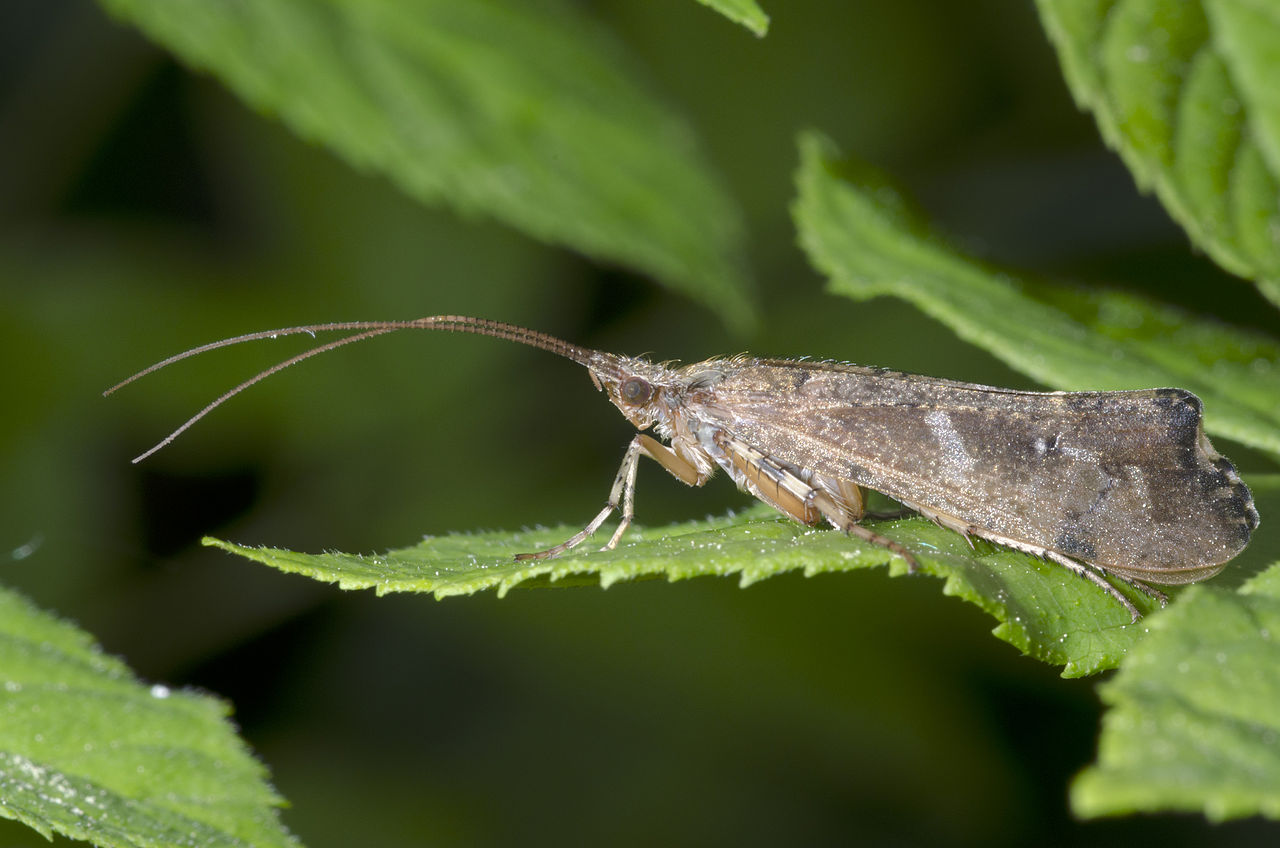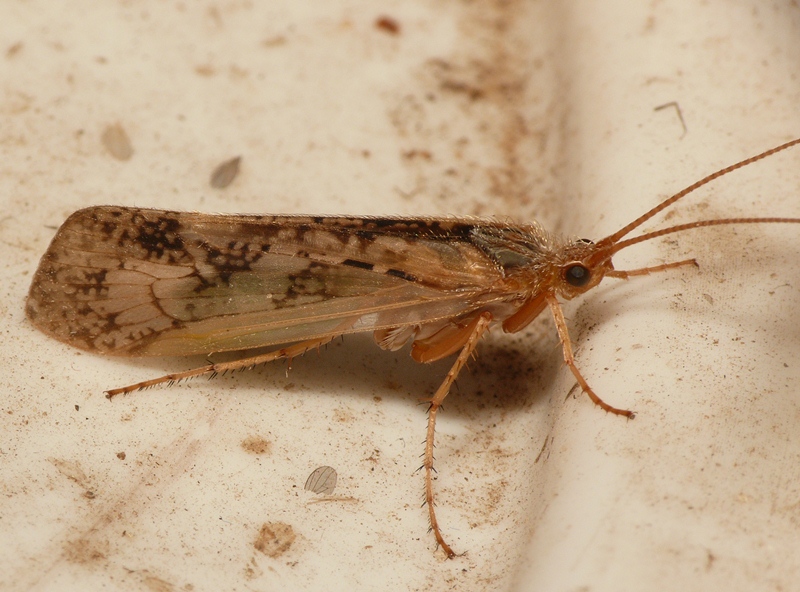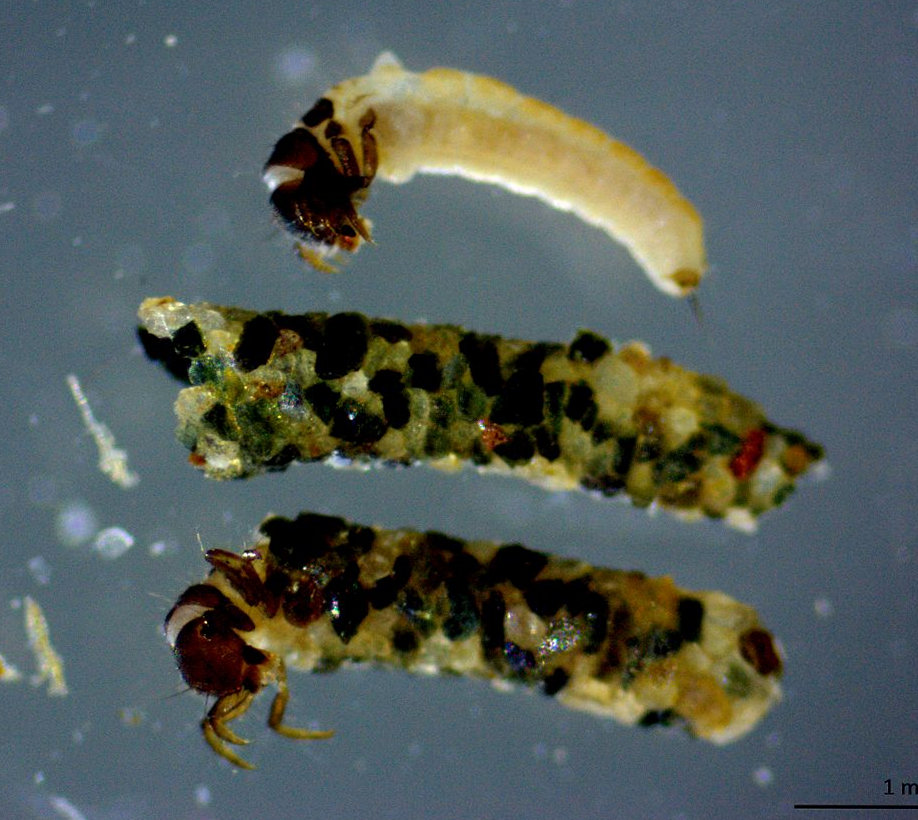Caddisflies
Caddisflies, also sometimes called sedge flies, belong to the insect order Trichoptera. They are closely related to butterflies and moths, and some have a moth-like appearance. In contrast, they have tiny hairs on their wings, rather than the flat overlapping scales found on the wings of moths. They have two pairs of wings that are folded back and held at a steep angle over the body when at rest. The long thread-like antennae often project forwards from the head. Most caddisflies are brownish in colour. Some have mottled or patterned wings. Caddisflies range from about 6-30mm in length.
Species in Britain and Ireland
Globally there are about 14,500 species known, with just under 200 species in Britain and Ireland. Jennifer Owen recorded 5 species in her Leicester garden, all caught in light traps. Some of the species likely to be associated with garden ponds are the mottled sedge, Glyphotaelius pellucidus; the cinnamon sedges, such as Limnephilus marmoratus, Limnephilus lunatus and Limnephilus rhombicus; the large cinnamon sedge Stenophylax vibex, the black silverhorn caddis, Mystacides azurea; and the grouse wing caddis, Mystacides longicornis.
Biology
Apart from one terrestrial species, all of the caddisflies found in Britain and Ireland have aquatic larvae. Some species require fast flowing streams and rivers, others develop as larvae in canals, lakes and ponds. Some species have free-living larvae, but most have larvae that enclose themselves within silk cases. Depending on the species, the silk case may have an outer covering of plant fragments, grains of sand or snail shells. The larvae are either predatory, especially the free-living case-less species, or they feed on algae and plant material.


.jpg)
.jpg)
Caddisfly adults. Top left: Glyphotaelius pellucidus Top right: Limnephilus marmoratus
Left: Stenophylax vibex
Below left: Mystacides longicornis
The adult insects sometimes feed on nectar but most are relatively short lived compared to the larval stage and probably do not feed. Some species fly at night and may be attracted to bright lights.
Life cycle
Female caddisflies mostly deposit their eggs into water, sometimes walking down below the surface to place eggs on submerged plants or stones. Limnephilus species often lay batches of gelatinous eggs on plants that overhang water. These eggs are stimulated to hatch during wet weather, when the rain will wash the larvae off the plants into the water below. Most species overwinter as larvae. When the larvae have completed their feeding, they pupate inside silk cocoons or within their cases. When the adult caddisfly is ready to emerge, the pupa leaves the cocoon or case and wriggles to the surface.
Some species of caddisfly have mating assemblies where males cluster together and fly up and down in a column above a fixed point on the ground. Females are attracted to the displaying males and move in to select a partner. Some species emerge and mate in spring-early summer but delay laying eggs until the autumn.
Role of caddisflies in gardens
Caddisflies are part of a healthy garden pond ecosystem. They cause no significant damage to pond plants. Fish will eat the larvae and pupal stages. Night-flying caddisflies can be an important food source for bats during the summer and autumn.
Other sources of information
Website
Website of the Freshwater Biological Association
Books
Barnard, P. & Ross, E. (2012) Handbooks for the Identification of British Insects. The adult Trichoptera (caddisflies) of Britain and Ireland. Royal Entomological Society
Dobson,M. Pawley,S. Fletcher,M. & Powell, A. (2012) Guide to Freshwater Invertebrates Published by Freshwater Biological Association
Edington, J. M. & Hildrew, A. G. (1995) Caseless caddis larvae (Trichoptera). Freshwater Biological Association
Mosely, M. E. (1939) The British caddis flies (Trichoptera). George Routledge & Sons
Wallace, I. D., Wallace, B. & Philipson, G. N. (2003) Keys to the case-bearing caddis larvae of Britain and Ireland. Freshwater Biological Association
Wallace, I. (2006) Simple key to caddis larvae. A Field Studies Council AIDGAP key
Page text drafted by Andrew Halstead, reviewed by Andrew Salisbury, compiled by Steve Head
Limnephilus caddisfly larvae and their cases.
Caddisflies
Caddisflies, also sometimes called sedge flies, belong to the insect order Trichoptera. They are closely related to butterflies and moths, and some have a moth-like appearance. In contrast, they have tiny hairs on their wings, rather than the flat overlapping scales found on the wings of moths. They have two pairs of wings that are folded back and held at a steep angle over the body when at rest. The long thread-like antennae often project forwards from the head. Most caddisflies are brownish in colour. Some have mottled or patterned wings. Caddisflies range from about 6-30mm in length.
Species in Britain and Ireland
Globally there are about 14,500 species known, with just under 200 species in Britain and Ireland. Jennifer Owen recorded 5 species in her Leicester garden, all caught in light traps. Some of the species likely to be associated with garden ponds are the mottled sedge, Glyphotaelius pellucidus; the cinnamon sedges, such as Limnephilus marmoratus, Limnephilus lunatus and Limnephilus rhombicus; the large cinnamon sedge Stenophylax vibex, the black silverhorn caddis, Mystacides azurea; and the grouse wing caddis, Mystacides longicornis.


.jpg)
Caddisfly adults. Top left: Glyphotaelius pellucidus Top right: Limnephilus marmoratus
Left: Stenophylax vibex
Below left: Mystacides longicornis
.jpg)
Biology
Apart from one terrestrial species, all of the caddisflies found in Britain and Ireland have aquatic larvae. Some species require fast flowing streams and rivers, others develop as larvae in canals, lakes and ponds. Some species have free-living larvae, but most have larvae that enclose themselves within silk cases. Depending on the species, the silk case may have an outer covering of plant fragments, grains of sand or snail shells. The larvae are either predatory, especially the free-living case-less species, or they feed on algae and plant material.
Limnephilus caddisfly larvae and their cases.
The adult insects sometimes feed on nectar but most are relatively short lived compared to the larval stage and probably do not feed. Some species fly at night and may be attracted to bright lights.
Life cycle
Female caddisflies mostly deposit their eggs into water, sometimes walking down below the surface to place eggs on submerged plants or stones. Limnephilus species often lay batches of gelatinous eggs on plants that overhang water. These eggs are stimulated to hatch during wet weather, when the rain will wash the larvae off the plants into the water below. Most species overwinter as larvae. When the larvae have completed their feeding, they pupate inside silk cocoons or within their cases. When the adult caddisfly is ready to emerge, the pupa leaves the cocoon or case and wriggles to the surface.
Some species of caddisfly have mating assemblies where males cluster together and fly up and down in a column above a fixed point on the ground. Females are attracted to the displaying males and move in to select a partner. Some species emerge and mate in spring-early summer but delay laying eggs until the autumn.
Role of caddisflies in gardens
Caddisflies are part of a healthy garden pond ecosystem. They cause no significant damage to pond plants. Fish will eat the larvae and pupal stages. Night-flying caddisflies can be an important food source for bats during the summer and autumn.
Other sources of information
Website
Trichoptera section of the Riverfly Partnership Website
Website of the Freshwater Biological Association
Books
Barnard, P. & Ross, E. (2012) Handbooks for the Identification of British Insects. The adult Trichoptera (caddisflies) of Britain and Ireland. Royal Entomological Society
Dobson,M. Pawley,S. Fletcher,M. & Powell, A. (2012) Guide to Freshwater Invertebrates Published by Freshwater Biological Association
Edington, J. M. & Hildrew, A. G. (1995) Caseless caddis larvae (Trichoptera). Freshwater Biological Association
Mosely, M. E. (1939) The British caddis flies (Trichoptera). George Routledge & Sons
Wallace, I. D., Wallace, B. & Philipson, G. N. (2003) Keys to the case-bearing caddis larvae of Britain and Ireland. Freshwater Biological Association
Wallace, I. (2006) Simple key to caddis larvae. A Field Studies Council AIDGAP key
Page text drafted by Andrew Halstead, reviewed by Andrew Salisbury, compiled by Steve Head
- Home
- Garden Wildlife
- Insects
- Caddisflies













